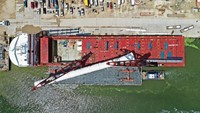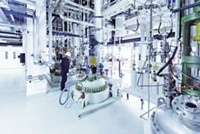Advertisement
Grab your lab coat. Let's get started
Welcome!
Welcome!
Create an account below to get 6 C&EN articles per month, receive newsletters and more - all free.
It seems this is your first time logging in online. Please enter the following information to continue.
As an ACS member you automatically get access to this site. All we need is few more details to create your reading experience.
Not you? Sign in with a different account.
Not you? Sign in with a different account.
ERROR 1
ERROR 1
ERROR 2
ERROR 2
ERROR 2
ERROR 2
ERROR 2
Password and Confirm password must match.
If you have an ACS member number, please enter it here so we can link this account to your membership. (optional)
ERROR 2
ACS values your privacy. By submitting your information, you are gaining access to C&EN and subscribing to our weekly newsletter. We use the information you provide to make your reading experience better, and we will never sell your data to third party members.
Business
Back To The U.S.
Study finds several manufacturing industries at the ‘tipping point’ of returning from China
by Michael McCoy
May 7, 2012
| A version of this story appeared in
Volume 90, Issue 19

The U.S. chemical industry’s chances against China looked dim in 2006 when Lanxess took apart a hydrazine plant in Texas, put the pieces on a ship, and sent it all to China, where the plant was reassembled and reopened. At the time, Lanxess said demand for the chemical was shrinking in the U.S. but growing at double-digit rates in China.
The industry’s prospects look a lot sunnier today, thanks in large part to low-cost raw materials extracted from shale formations. And a new survey by the Boston Consulting Group (BCG) suggests that things could get even better as manufacturing operations that were sent to China come back to the U.S.
More than a third of U.S.-based manufacturing executives at companies with annual sales greater than $1 billion are considering bringing production back to the U.S. from China, according to the survey. Conducted with decisionmakers at 106 companies across a range of industries, the survey found that factors such as labor costs, product quality, ease of doing business, and proximity to customers are behind the consideration to come home, a phenomenon that BCG calls reshoring.
The results are consistent with earlier BCG findings on changes in economics that are starting to favor the manufacture of certain goods in the U.S. In reports published in August 2011 and March 2012, BCG partner Michael Zinser and colleagues documented the decline of China’s once-enormous cost advantage as an exporter to the U.S.
In 2000, they found, Chinese factory workers earned a mere 3% of their U.S. counterparts’ wages. But by 2015, workers in China’s main high-tech manufacturing region will be earning around 25% of what U.S. workers earn in low-cost states. Take much higher U.S. worker productivity into account, and Chinese labor costs are 60% or more of U.S. costs, BCG calculates.
The industries closest to the “tipping point” for moving back to the U.S. include rubber and plastic goods, industrial machinery, and electrical equipment. The chemical industry isn’t considered close to returning mostly because, Lanxess aside, it didn’t move offshore to an appreciable extent.
Still, reshoring is likely to benefit the U.S. chemical industry. Although BCG has yet to dig into the secondary effects of reshoring, Zinser tells C&EN that the return of chemical-consuming companies to U.S. shores should work to the industry’s benefit. “For the same reasons that we are seeing the tipping point, someday these companies may be looking for the cost advantage of suppliers that are close to home,” he says.
Among the examples of reshoring documented in BCG’s research is Coleman’s decision to move production of its 16-qt wheeled plastic coolers from China to Wichita, Kan., owing to rising Chinese manufacturing and shipping costs.
Other companies are building facilities in the U.S. that in the past they might have sited in China or elsewhere overseas. Last month, for instance, Michelin announced it will spend $750 million to build an Earthmover tire plant in Anderson, S.C. Thus, although Lanxess is not likely to bring its hydrazine plant back from China, it still runs a large synthetic rubber plant in Texas for which Michelin’s new U.S. tire factory could soon be a customer.




Join the conversation
Contact the reporter
Submit a Letter to the Editor for publication
Engage with us on Twitter